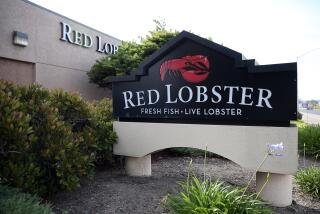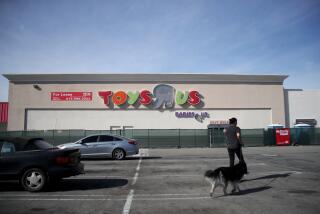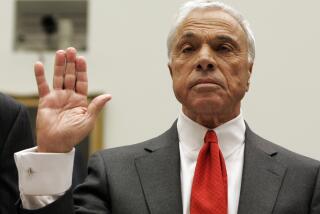Underwriters Re Stepping Out of Public Spotlight : Reinsurance: The Woodland Hills firm is returning to private status by retiring publicly held junk bonds it issued five years ago.
- Share via
Reinsurance is not what you’d call Topic A at dinner parties. It’s an unsexy business, not easily understood and filled with companies with odd names that seem accidentally chopped off, such as General Re and American Re.
Reinsurance serves a purpose, though. So-called primary insurers that deal with the public, such as Allstate, buy reinsurance so that if they’re hit with big claims from a hurricane, flood or some other catastrophe, they can shoulder the cost with another company. The reinsurer, in turn, gets a slice of the premiums paid to the primary carrier.
And reinsurance is getting attention on Wall Street these days. Stocks of three publicly held reinsurers--General Re Corp., National Re Holdings Corp. and Transatlantic Holdings--are up sharply this year. Plus, takeover specialist Kohlberg Kravis Roberts & Co. plans to take American Re Corp. public for three times the price it paid to buy the company only three months ago from Aetna Life & Casualty Co.
Yet for all the buzz surrounding reinsurance, Underwriters Re Corp., a reinsurer based in Woodland Hills, isn’t anxious to discuss its affairs. Peter A. Bengelsdorf, Underwriters Re’s chief financial officer, said neither he nor Chairman Steven H. Newman wanted to be interviewed about their company.
Perhaps that’s because UR, which has about 120 employees, is returning to private status by retiring publicly held high-yield junk bonds it issued five years ago. The company’s recent filings with the Securities and Exchange Commission also show that UR has been building its profitability in recent years while paring that burdensome debt load.
UR was created in late 1987 to buy the Buffalo Reinsurance Co. unit of Continental Corp., an insurance holding company in New York. UR was formed by Continental and a partnership group affiliated with the investment banker Goldman, Sachs & Co., and each today still owns 42.6% of the company. The remaining 14.8% is owned by Newman and other UR insiders.
Thus, UR has no public stockholders. But the company is still required to file public financial statements with the SEC because it issued $160 million of junk bonds--specifically 10-year notes yielding 15%--to the public in 1987 to help finance the Buffalo Reinsurance purchase.
UR has since pared that costly debt to about $102 million, and, having recently obtained a $100-million credit package from First National Bank of Chicago, plans to redeem the junk bonds. The bonds become eligible for redemption on Thursday.
Replacing the junk bonds with the bank debt will save UR roughly $10 million in interest costs in the first year alone, assuming there’s no major change in interest rates. The swap also will effectively make UR completely private by removing the need for its SEC filings. Among the things the company won’t have to reveal anymore is how much its executives are paid. In 1991, chairman Newman’s compensation totaled $517,000.
UR’s debt-cutting effort also has swollen the company’s net worth--how much its assets surpass its debts--to $130.8 million as of Sept. 30 from a mere $15.7 million four years earlier.
The company’s earnings have been somewhat choppier, but overall UR has remained profitable despite its debt expenses. In 1991, UR earned $28.2 million on total revenue of $194 million, which included $57 million of investment income, for a handsome after-tax profit margin of 14.5 cents per dollar of revenue.
UR’s “net written premiums”--an industry measure of revenue from its insurance operations alone--last year totaled $125.1 million, so the company’s profit represented 23 cents for each premium dollar.
By comparison, General Re, which is 18 times larger than UR, had a 1991 profit margin on written premiums of 29 cents.
But like many other property/casualty insurers, UR actually seldom earns a dime from underwriting insurance; its claims losses and overhead costs eat up UR’s premium income and then some. So UR’s profits come from those investment earnings.
Even in good years, earning a profit from property and casualty insurance isn’t easy because the insurers routinely engage in rampant price-cutting to maintain market share. But it was nearly impossible in 1992.
The hurricanes Andrew (in August) and Iniki (in September) caused more than $10 billion in damage, and together with other disasters they will probably make 1992 “a record year for catastrophes,” according to the securities research firm Value Line Investment Survey.
Reinsurance softens those losses for the primary carriers, but they still wound the reinsurers, of course. In this year’s third quarter, UR took an after-tax, $3.8-million charge against earnings to cover its losses from Andrew and Iniki.
Nonetheless, UR wants to take a swing at being a direct seller of property-casualty insurance itself, so in October the company formed Commercial Underwriters Insurance Co. and hired as president Harry Petru Jr., who came from Topa Insurance Co., a carrier owned by Los Angeles multimillionaire John E. Anderson.
Why get into a business that’s notorious for its price-cutting and cyclical profits? UR’s latest SEC statements don’t say, and its executives aren’t saying either.
Underwriter Re Corp. at a Glance Underwriters Re Corp. is the Woodland Hills-based parent of Underwriters Reinsurance Co., which provides reinsurance to so-called primary providers of property and casualty insurance. As a reinsurer, Underwriters Reinsurance shares the risk with the primary insurers in exchange for a portion of the premium fees they receive.
More to Read
Inside the business of entertainment
The Wide Shot brings you news, analysis and insights on everything from streaming wars to production — and what it all means for the future.
You may occasionally receive promotional content from the Los Angeles Times.











